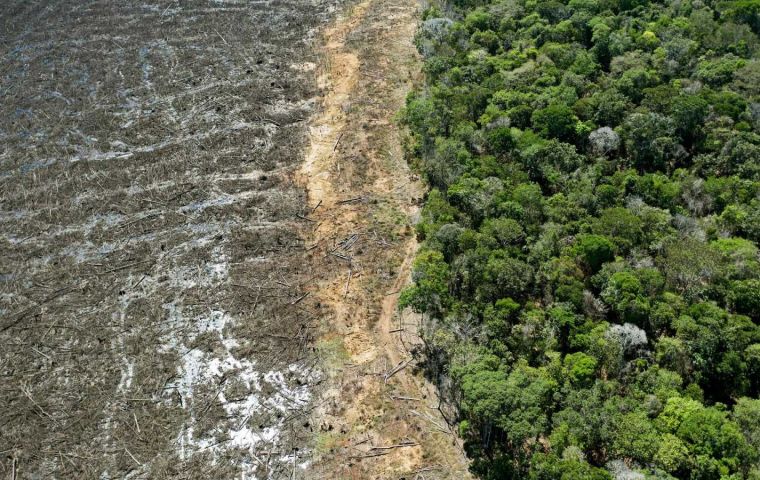MercoPress. South Atlantic News Agency
Deforestation in Amazon drops 31% interannually
 From January to May this year, there was a 31% drop in deforestation,” João Paulo Capobianco said at a press conference.
From January to May this year, there was a 31% drop in deforestation,” João Paulo Capobianco said at a press conference. According to Brazil's National Institute for Space Research (INPE), deforestation fell 31% in the Legal Amazon, from January to May 2023, compared to the same period last year, Agencia Brasil reported.
The data was released Wednesday and collected from the Deforestation Detection System in Real Time (Deter), available on the TerraBrasilis platform. There were 1,986 square kilometers (km²) of deforested area in the first months of this year against 2,867 km² of deforested area between January and May 2022, which figure represents a reversal of the deforestation trend, which increased as much as 54% in the second half of last year.
“The current government received [from the previous administration] the deforestation in high rates in the Amazon, in a very important range. The data that Deter has just made available represents a drop of 10% in the month of May, compared with May of the previous year. From January to May this year, there was a 31% drop in deforestation,” Ministry of Environment and Climate Change (MMA) Executive Secretary João Paulo Capobianco said at a press conference.
The Deter system is a rapid survey of alerts of evidence of changes in forest cover in the Amazon, done by Inpe, as a way to guide the work of environmental enforcement. It is not usually used to analyze short periods, such as month-to-month comparisons, because of the high volatility of the cloud cover. According to information from the MMA, about 46% of the deforestation, occurred on rural properties with a public register in the Rural Environmental Registry (CAR), in which the government can identify the person responsible for the area, be it an owner or a squatter in the process of land regularization.
Another 21% of the deforested area was in rural settlements and 15% in areas of undesignated public forests. Smaller percentages were observed in conservation units, indigenous lands, and permanent preservation areas.
According to the federal government, only 20 municipalities in the Legal Amazon concentrated 55% of the deforestation detected from January to May. The municipality of Feliz Natal (MT) leads this statistic, with 8.8% of deforestation, followed by Apuí (AM) and Altamira (PA), with 6.8% and 4.9%, respectively. In all, there are eight municipalities in Mato Grosso, six in Amazonas, four in Pará, one in Rondônia, and one in Roraima. Together, they accounted for a deforested area of almost 2,000 km².
“A good part of the deforestation in the Amazon is illegal, unauthorized”, explains the president of the Brazilian Institute for the Environment and Renewable Natural Resources (Ibama), Rodrigo Agostinho. The work of the autarchy in this period resulted in the application of more than R$ 2 billion in fines (around US$ 400 million), an increase of 179% in relation to last year.
According to the president of Ibama, 7,196 notices of violation were issued and more than 2.2 thousand farms, plots, or rural lots were embargoed, that is, their activities were prohibited.
“We are embargoing preferentially in the priority municipalities for deforestation. The deforestation frontier in the Amazon is large, extending from Rondônia, Acre, southern Amazonas, northern Mato Grosso, as well as Pará and Maranhão,” he added.
This week, the federal government launched the new edition of the Plan to Prevent and Combat Deforestation in the Legal Amazon (PPCDAm), which has been under discussion since the beginning of the year and was submitted to public consultation in April, with more than 500 suggestions received. The document establishes more than 130 goals to be reached by 2027, including embargoes of deforested areas, suspension of irregular registrations, application of fines, hiring of personnel, increase in the inspection of areas, and land-ownership title regularization, among others.
The plan also includes targets to stimulate sustainable production activities, such as the creation of family farming and bio-economy stamps, forest and ecological management programs, and an incentive to ethno-tourism in the Amazon, among others. There are also plans to create new conservation units, allocate federal public forests and regularize traditional peoples and communities.
While deforestation in the Amazon shows signs of being contained this year, in the Cerrado, the second-largest biome in the country, the situation is quite the opposite. The Deter data released Wednesday show a 35% increase in deforestation from January to May this year, compared with the same period last year.
(Source: Agencia Brasil)




Top Comments
Disclaimer & comment rulesCommenting for this story is now closed.
If you have a Facebook account, become a fan and comment on our Facebook Page!